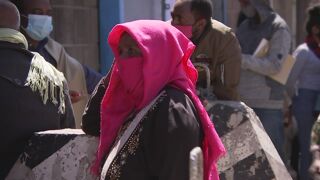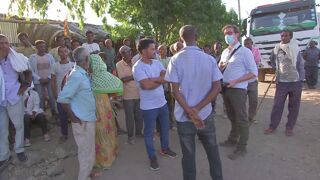Source: VRT News
[Note article was originally in Dutch and this is a computer translation. The videos show Eritrean tanks laden with looted goods from Shire. They also interview Eritrean refugees who fled from Tigray in Addis Ababa and Gondar, Amhara militia and staff at a Shire hospital. Interviews in Amharic, Tigrinya and English.]
To view the videos in this report see the original report above]
VRT NWS first in north Tigray in Ethiopia: “This is a developing humanitarian disaster”

In recent weeks, Ethiopia’s army has waged a bloody offensive against local forces in Tigray province.
There was no internet and no one was allowed to enter the area. Now some areas controlled by the government army are admitting aid workers and journalists.
Our VRT NWS team was the first to go to the area where no one had come before. He spoke to refugees and identified an acute shortage of humanitarian aid.
Tigray was completely closed in recent weeks. It was impossible for outsiders to visualize what was really going on at the front.
Aid workers were also not allowed in, despite the fact that there were also hundreds of thousands of Eritrean refugees in relief camps in Tigray. 1 million Tigreans would have fled their home.
Now that the army has taken large parts of the area, the government is slowly letting in foreigners. Our colleague Stijn Vercruysse and his team first went to the southwest of Tigray, in the area of Gondar. “In the meantime help has been allowed there and the army is present.”
View here the report from “Het Journaal” by our reporter Stijn Vercruysse from Gondar, on the border with Tigray.

“A bit further, we passed ghost villages”, says journalist Stijn Vercruysse in “The morning” on Radio 1. “That’s what we feared. There were corpses on the road and we saw burnt-out tanks, but also buses with bullet holes in them. The people who stayed behind say they have no food, no water, and no medicine. ”
Watch a report from “Het Journaal” in which Stijn Vercruysse speaks with refugees (read more below the video):

The team also encountered Eritrean refugees on the way, who were staying in camps in Tigray. They say they have been chased away. Now that aid organizations cannot reach those camps, there would also be a serious shortage of food and medicine.
In the meantime, fighting continues in various places. But even in places where the fighting seems to be over, people do not dare to return to their homes because they are afraid of Eritrean soldiers who loot houses and harass people.
“We have been able to establish that everything indicates that Eritrean soldiers have crossed the border wearing Ethiopian uniforms”, says Stijn Vercruysse. “It appears that they participated in the fighting and that they are at least helping to secure the region. But instead of securing, they would plunder the Tigreans’ homes.”
Watch the conversation with Stijn Vercruysse from Addis Abeba in “Het Journaal” about the Eritrean soldiers in Tigray below.

Last week, the European Union postponed financial aid to Ethiopia because of the war in Tigray. It concerns 88.5 million euros. One of the conditions for paying the amount is the restoration of the communication lines in the Tigray region. At the moment, communication with people in the region is still very difficult.
Stijn Vercruysse spoke with Tigreans in the Ethiopian capital Addis Ababa, who had been out of contact with their relatives in the region for weeks. Watch the report from “Het Journaal” here.

Now that Stijn Vercruysse was one of the first journalists to enter the region for VRT NWS, it appears that the situation in Tigray is, as feared, very precarious: “Now, above all, more access is needed for humanitarian organizations, because we have seen that a humanitarian disaster is developing. ”
View an extensive report from “Terzake” (21/12/2020) by our reporter on site, Stijn Vercruysse:





















